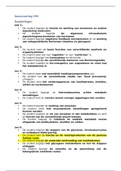Samenvatting V&E
Doelstellingen:
Les 1:
De student begrijpt de functie en werking van hormonen en andere
signalering moleculen.
De student begrijpt de algemene intracellulaire
signaleringsmechanismen van hormonen.
De student begrijpt negatieve feedback mechanismen en de werking
van antagonistische hormonen (insuline en glucagon).
Les 2:
De student kent de basis functies van verschillende weefsels en
orgaansystemen.
De student weet wat een ‘regulator’ en een ‘conformer’ is.
De student begrijpt hoe homeostase wordt bereikt.
De student begrijpt de verschillende manieren van thermoregulatie.
De student begrijpt de bio-energetica van organismen en weet wat
het metabolisme is.
Les 3:
De student weet wat essentiële voedingscomponenten zijn.
De student kan de verschillende stadia van ‘food processing’
uitleggen.
De student kent het verteringsproces van koolhydraten, eiwitten,
vetten en nucleïnezuren.
Les 4:
De student begrijpt de thermodynamica achter metabole
omzettingen.
De student kent de vormen waarin energie opgeslagen kan worden.
Les 5:
De student begrijpt de werking van enzymen.
De student weet hoe enzymatische omzettingen gereguleerd
kunnen worden.
De student begrijpt de rol van enzymen in het metabolisme en kent
de functie van de verschillende enzym klassen.
De student begrijpt de katabole en anabole metabole routes
uitgaande van koolhydraten, eiwitten en vetten.
Les 6:
De student begrijpt de stappen van de glycolyse, citroenzuurcyclus
en oxidatieve fosforylering.
De student kent de functie en de reactieproducten van de pentose
fosfaat route.
De student begrijpt de anaerobe verbranding van koolhydraten.
De student begrijpt het glycogeen metabolisme en kan de stappen
uitleggen.
De student begrijpt de essentie en de samenhang van de
belangrijkste metabole routes.
, De student kan de (energetische) consequenties verklaren van
afwijkingen in metabole routes.
,Les 1:
• Animal hormones are chemical signals that are secreted into the
circulatory system (bloodstream) and communicate regulatory
messages within the body (maintain homeostasis). (LEERDOEL)
• Hormones reach all parts of the body, but only target cells have
receptors for that hormone.
• Two systems coordinate communication throughout the body: the
endocrine system and the nervous system.
• The endocrine system secretes hormones that coordinate slower
but longer-acting responses including reproduction, development,
energy metabolism, growth, and behavior.
• The nervous system conveys high-speed electrical signals along
specialized cells called neurons; these signals regulate other cells
(neurons, muscles and endocrine cells).
Concept 45.1: Hormones and other signaling molecules bind to
target receptors, triggering specifc response pathways.
• Endocrine signaling is just one of several ways that information is
transmitted between animal cells = intercellular communication.
(LEERDOEL)
• The ways that signals are transmitted between animal cells are
classifed by two criteria:
- The type of secreting cell.
- The route taken by the signal in
reaching its target.
Paracrine and Autocrine Signaling
• Local regulators are molecules that
act over short distances, reaching
target cells solely by difusion.
• In paracrine signaling, the target
cells lie near the secreting cells.
• In autocrine signaling, the target
cell is also the secreting cell.
• Types of local regulators
– Cytokines and growth
factors
– Nitric oxide (NO)
– Prostaglandins
, Synaptic and Neuroendocrine Signaling
• In synaptic signaling, neurons form specialized junctions with target
cells, called synapses.
• At synapses, neurons secrete molecules called neurotransmitters
that difuse short distances and bind to receptors on target cells.
• In neuroendocrine signaling, specialized neurosecretory cells secrete
molecules called neurohormones that travel to target cells via the
bloodstream.
Signaling by Pheromones (Feromonen)
• Members of the same animal species sometimes communicate with
pheromones, chemicals that are released into the environment.
• Pheromones serve many functions, including marking trails leading
to food, defning territories, warning of predators, and attracting
potential mates.
Endocrine Tissues and Organs
• In some tissues, endocrine cells are
grouped together in ductless organs
called endocrine glands.
• Endocrine glands secrete hormones
directly into surrounding fuid.
• These contrast with exocrine glands,
which have ducts and which secrete
substances onto body surfaces or
into cavities.
Chemical Classes of Hormones
Three major classes of molecules
function as hormones in vertebrates
• Polypeptides (proteins and
peptides)
• Amines derived from amino acids
• Steroid hormones vet-oplosbaar
• Lipid-soluble hormones pass easily through cell membranes,
while water-soluble hormones do not.
• The solubility of a hormone correlates
with the location of receptors inside or on
the surface of target cells.
• Voorbeeld van een wateroplosbare
polypeptiden is insuline, van amines is
adrenaline een voorbeeld.






